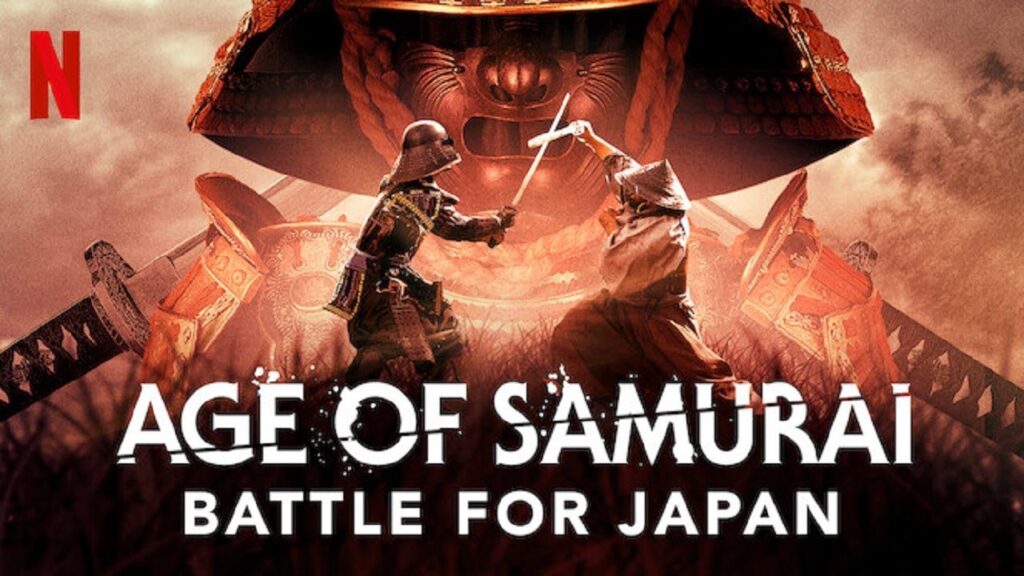As the Japan Fans Utrecht wish to form friendship bonds with people from all over the world who take an interest in Japan, we are very happy to announce our collaboration with 戦国之武士道 (Bushido of the Warring States), a Japanese living history group within the Queensland Living History Federation, in Brisbane (Australia). From their background, knowledge and experience they review the 2021 Netflix production “Age of Samurai: Battle for Japan”.
“This series has gained a significant following and a clear rise in popularity since it has aired on Netflix. Due to this, our own specialisation in this period (Momoyama to Azuchi-Momoyama eras), and also questions we have been asked on this series, we feel that a review on the series from our perspective is in order. There is also a very interesting and informative podcast on this series, which can be accessed here.”
“We will, first, start on the positives. One aspect that this series effectively promotes is the interest in the Japanese warring states era, otherwise referred to as the Sengoku era. It has opened a very rich world for people who may otherwise not be exposed or even aware of this era’s existence, let alone its significance. This should, at least in part, be one of the most important aims a series such as this should be aiming for. In addition, it does this not by romanticising the combat but, instead, attempts a look at the era for what it was and how it truly affected the Japanese people. This era and its combat, like any combat to the death in any era or geographic location, is bloody, gory, and brutal.
A second aspect that we very much appreciated was the yoroi (armour) that was provided by Iron Mountain Armory; their suits are almost always an accurate recreation of armour from various periods of Japanese history. In addition, certain aspects of the costuming are also accurately shown, such as the jinbaori (a form of coat worn outside of the armour). Thirdly, this series presents the opinion of various highly respectable academics on Japanese history such as Dr. Stephen Turnbull in the role of talking heads throughout the series.
Fourthly, the actor who plays Toyotomi Hideyoshi is almost an exact physical appearance match for the historical individual according to illustrations. Therefore, as one can see, there are certainly clear positive aspects inherent in this series.

Now, we will start to discuss the aspects that were either negative and/or require a form of revision or edit to improve the quality of the series in terms of historical and martial accuracy. The first aspect we found lacking was one of the first concepts present, the hairstyles. The hairstyles of all the men in this series are very much representative of manga characters and not of actual historical hairstyles as described in illustrations and written accounts.
The second representation we found to be strange was the depiction of Oda Nobunaga. In the series, Nobunaga is represented as, to put it simply, a blood-crazed maniac. What we know from history is that Nobunaga was adept at being brutal to his enemies, like many other lords were at this time; in his young-age, he was certainly very ignorant. However, we experience a sharp change in his personality since the battle of Okehazama (1560). We very much see not just a commander who is a brilliant and innovative tactician, but also heavily interested in new ways of doing and understanding (including religion and technology from the west). He was also a man who freed an African slave and had him fight as one of his own men, this man was renamed Yasuke and is a fascinating individual. While this does not make Nobunaga a perfectly virtuous individual, it means that it is important not to paint him as either a ‘Master Yoda’ or a ‘King Jeoffery from HBO’s Game of Thrones’. The physical look of the actor who played Nobunaga also did not match the historical individual’s appearance, however this is a very minor issue and is contrasted by the actor’s acting ability.
The third issue we found was that none of the main characters are pictured wearing helmets at any moment, including every combat scene. This is found not only scenes where an individual was taken by surprise (in which case not wearing a helmet could be forgiven) but also in scenes where the individual consciously decides to enter battle. This may be to ensure that the character’s face is not hidden for film purposes, but a kabuto (helmet) without a full or half-face mask has the wearer’s face perfectly visible. We found it very odd, and also historically (and practically) inaccurate that these individuals were consciously choosing to fight every battle without a helmet.
The fourth negative aspect we found in this series was the armour for many of the ashigaru (the commoner foot soldiers). Unlike the armour provided by Iron Mountain Armory, we see very strange studded leather jerkins which we have not been able to find referenced to in most if not any Japanese armour research. While leather armour certainly existed, it most certainly did not exist in this form. We found this to be a very strange aspect to include in a series that claims to be enforced with historical research and sources.
The fifth concept is a minor issue and not as significant as the other critiques, however the series depicts Toyotomi Hideyoshi (when he was an ashigaru) killing Imagawa Yoshimoto at the battle of Okehazama. We are almost certain that Hideyoshi was not the soldier that killed the Imagawa Daimyō, as all evidence suggests it to be another warrior. Hideyoshi would certainly have been in that battle, however there is no evidence at all to suggest he was the individual that killed Yoshimoto.
The sixth issue was the prevalence of the katana over polearms, particularly the yari (spear), as well as the portrayal of the role of the katana. We know that the katana and the tachi were almost always secondary weapons (like a handgun is to a soldier with an assault rifle). The only instances we hear of the sword being a primary battlefield weapon is during sieges. We know, from written accounts from the era and also research of weapon use and forensic studies on bodies from this era, that the polearm (particularly the yari) ruled supreme on the battlefield, particularly during the Sengoku era. We see a marked increase on spear injuries from the 1460s onwards, and every illustration of battlefields in this era portrays almost every warrior with a spear. Unfortunately, in the Netflix series, the katana is everywhere with only very few poor arms shown. There are also very few battle field formations portrayed in this series, which we also know to be one of the key factors of warfare at this time. Discipline in formations was crucial, and the importance of this is also repeatedly highlighted in the 17th century Zohyō Monogatari.
In terms of how the katana is portrayed, this series unfortunately chooses to promote the romanticised image of this weapon being the best sword in the world with its accompanying mythology. We know for a fact that well-made katana and tachi were very effective and deadly weapons. However, this does not mean they were the best in the world, and this misconception is promoted by the series when it states “the Japanese sword, widely regarded as probably the finest sword ever made in world history”. This completely glosses over plenty of other incredible weapons such as the European longsword, arming sword, and sabre which, arguably in some cases, utilise higher quality steel. This romanticised idea in the show (and in popular media, even in certain historical circles) covers not only the katana, but also the samurai themselves, claiming they were “the best warriors of all time”. This claim is, in short, ignorant of all other warrior and soldier cultures from around the world throughout various eras and buys into the all-too-common image of the ‘invincible samurai’. Shows like this should, at least in our opinion, work on dispelling these popular myths while still maintaining respect for these warriors. The samurai were, like any warrior elite, highly effective warriors and killing machines that were rightly feared on the battlefield (particularly in the Sengoku era). They were not philosophical super humans.
The seventh negative aspect is, while a minor issue, how lethal strikes are delivered in the series and also the action of chiburui (flicking the blood off of the sword). While some of the strikes are effectively shown, there are various instances where a katana is used to completely pierce the dō (cuirass) of iron and steel armour. The very existence of combat systems such as Katori Shinto Ryu, and virtually any other armoured combat system around the world, proves why showing this in a series is highly inaccurate. If plate armour could be pierced so easily in this way, then its existence and effectiveness would rightly be heavily debatable.
Concerning chiburui, this is a quick ‘flicking’ motion often performed after a technique with the sword that symbolises ‘cleaning the blade’. There is no evidence of this being performed in or after battle by any warrior in Japan and, even if it was, its ability to properly clean the blade is exceptionally doubtful. This is an image often promoted by popular media and video games, and a misinterpretation. Rather, we know that the sword (or weapon in general) would be cleaned, according to Natori Ryu, with one’s spare sandal, one’s tenugui (towel to carry on one’s person), or simply a spare piece of cloth, before returning it to the sheath. In fact, chiburui was originally developed, according to our research, to demonstrate the end of a technique rather than to effectively clean the sword. When one tries to clean one’s blade after cutting through offal, purely by doing chiburui, one will find that this does not work.
Our final contention that we have with the series is mixed, and focuses on the post-battle ‘head viewing ceremony’ that occurred in Japan. The series does not shy away from this aspect, and it is wonderful to see that they have chosen to include this in the docuseries. However, they make the claim that this was done in part to ‘mock the opponent’. There is very little evidence to suggest that this was part of the reason for the ceremony. In fact, all evidence points to the fact that every collected head was treated with the utmost care and reverence, with every head being cleaned and even the hair perfectly styled. We also know that many warriors, particularly men of status, perfumed their head so that, if they were to be beheaded, they would not offend those to whom their head was presented.
Altogether, there were other small issues we found with the series, such as their explanation of the people of Iga, but we decided to choose the most noticeable and crucial ones for this review. Overall, we think that this Netflix docuseries sets out with a very noble cause and, in certain ways, effectively achieves it. However, unfortunately, the series also commits various historical inaccuracies and promotes certain romanticised concepts of the katana and the samurai. We hope that this series has, at the very least, inspired your interest in this era, and that the makers of the series pay close head to the words of not only their supporters but also to those who provide respectful and well-informed critiques of the docuseries.”
This review was written by our Australian friends from 戦国之武士道 (Bushido of the Warring States) –
ありがとうございました! If you’d like to find our more about this Japanese living history group, just check out their homepage and Facebook.
